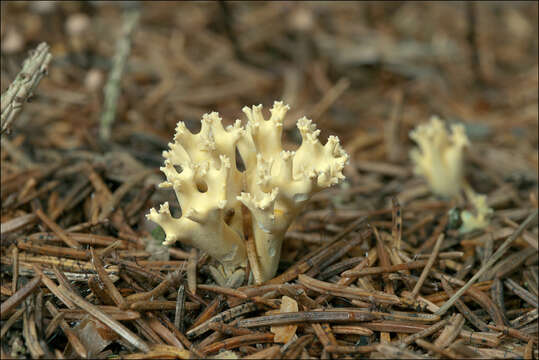Ramaria-abietina_5

Description :
Ramaria abietina (Pers.; Fr) Quel., Syn.: Ramaria chraceovirens (Jungh.) DonkGreen-staining Coral Mushroom, DE: Gelbgrne Korale, Fichten-ZiegenbartSlo.: jelkina griva / zelenea grivaDat.: Oct. 09. 2013Lat.: 46.40353 Long.: 13.70662Code: Bot_759/2013_DSC8566Habitat: overgrown alluvial deposits of an alpine river, a small patch of an open, pure Picea abies forest growing on long time abandoned alpine pasture; calcareous ground, flat terrain; deep shade, partly protected from direct rain by tree canopy, average precipitations ~ 3.000 mm/year, average temperature 4-6 deg C, elevation 970 m (3.200 feet), alpine phytogeographical region.Substratum: deep layer of Picea abies needles and humus under a 'roof' of low, dense Picea abies branches. Place: Zadnja Trenta valley, south of the Fjori farmhouse, left bank of dry Soa river bed (Suec), East Julian Alps, Posoje, Slovenia EC Comments: Genus Ramaria is difficult regarding species determination. I rarely find something, which would perfectly fit to the books. However this observation seems quite reliable, because of typical habitat, substratum and habitus. In addition spores fit expectations too. Growing gregariously, most of about ten fruit bodies in a row; fruit bodies' dimensions up to 4 x 4 x 3 cm; taste slightly bitter, smell indistinctive, mushroomy; flesh quite firm and pliant; SP brown, oac869. Fruit bodies becoming slowly dirty greenish-gray when handled.Spores spiny. Dimensions: 7 [8 ; 8.4] 9.4 x 2.1 [3.7 ; 4.4] 6 microns, Q = 1.5 [2 ; 2.2] 2.7; N = 31; C = 95%, Me = 8.2 x 4 microns; Qe = 2.1. Olympus CH20, NEA 100x/1.25, magnification 1.000 x, oil, in water. AmScope MA500 digital camera.Herbarium: Mycotheca and lichen herbarium (LJU-Li) of Slovenian Forestry Institute, Vena pot 2, Ljubljana, Index Herbariorum LJFRef.:(1) J. Breitenbach, F. Kraenzlin, Eds., Fungi of Switzerland, Vol.2. Verlag Mykologia (1984), (2) E. Schild, Was ist Ramaria aurea und Ramaria flava, Z. Mycol., Vol.44, no 2. (1978), p 171.cited in Ref.:(1) (3) S. Buczacki, Collins Fungi Guide, Collins (2012), p 462. (4) M. Bon, Parey's Buch der Pilze, Kosmos (2005), p 308. (5) G. J. Krieglsteiner (Hrsg.), Die Grosspilze Baden-Wrttembergs, Band 2, Ulmer (2000), p 64. (6) D. Arora, Mushrooms Demystified, Ten Speed Press, Berkeley (1986), p 650.
Inclus dans les pages suivantes :
- Life
- Cellular (Organismes cellulaires)
- Eukaryota (eucaryotes)
- Opisthokonta
- Nucletmycea
- Fungi
- Dikarya
- Basidiomycota
- Agaricomycetes
- Gomphales
- Gomphaceae
- Phaeoclavulina
- Phaeoclavulina abietina
Cette image ne figure dans aucune collection.
Informations sur la provenance
- licence
- cc-by-nc-sa
- droit d’auteur
- Amadej Trnkoczy
- photographe
- Amadej Trnkoczy
- original
- fichier de média d’origine
- visiter la source
- site partenaire
- Flickr Group
- ID


